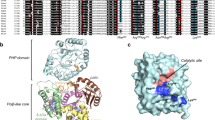Abstract
Local sequence similarity exists between the subunit 2 of eukaryotic RNA polymerases II and the barnase-type bacterial RNases. The RNase-like domain from the Rpb2 ofSchizosaccharomyces pombe was expressed inEscherichia coli as a GST fusion protein and examined for its RNase activity. When the GST fusion protein was incubated in vitro with32P-labeled RNA, the RNA degradation activity was less than 0.1%, if any, of the level of synthetic barnase. In order to check the in vivo function of this region, we constructed two mutantrpb2 alleles,rpb2 E357A andrpb2 H3a6L, each carrying a single amino acid substitution at the site correponding to one of the three essential amino acid residues forming the catalytic site in barnase (mutation of barnase at the corresponding sites results in complete loss of RNase activity) and five other mutantrpb2 alleles, each carrying a single mutation at various positions within the RNase-like domain but outside the putative catalytic site for RNase activity. When these mutantrpb2 alleles were expressed in anrpb2-disruptedS. pombe strain, all the mutants grew as well as the wild-type parent and did not show any clear defective phenotypes. These results suggest either that the RNase-like domain in Rpb2 does not function as an RNase in vivo or that the RNase activity of this domain, if present at all, is not essential for cell growth.
Similar content being viewed by others
References
Azuma Y, Yamagishi M, Ishihama A (1991) Cloning and sequence determination of theSchizosaccharomyces pombe gene encoding the largest subunit of RNA polymerase II. Nucleic Acids Res 19:461–468
Azuma Y, Yamagishi M, Ishihama A (1993) Subunits of theSchizosaccharomyces pombe RNA polymerase II: Enzyme purification and structure of the subunit 3. Nucleic Acids Res 21:3749–3754
Borukhov S, Polyakov A, Nikiforov V, Goldfarb A (1993) GreA protein: a transcription elongation factor fromEscherichia coli. Cell 72:459–466
Egel R, Egel-Mitani M (1974) Premeiotic DNA synthesis in fission yeast. Exp Cell Res 88:127–134
Gutz H, Heslot H, Leupold U, Loprieno N (1974)Schizosaccharomyces pombe. In: King RD (ed) Handbook of genetics, Plenum Press, New York-London, pp 395–445
Hill C, Dodson G, Heinemann U, Saenger W, Mitsui Y, Nakamura K, Borisov S, Tischenko G, Polykov K, Pavlovsky S (1983) The structural and sequence homology of a family of microbial ribonucleases. Trends Biochem Sci 8:364–369
Ishihama A (1981) Subunit assembly ofEscherichia coli RNA polymerase. Adv Biophys 14:1–35
Izban MG, Luse DS (1992) The RNA polymerase II ternary complex cleaves the nascent transcript in a 3′–5′ direction in the presence of elongation factor SII. Genes Dev 6:1342–1356
Kawagishi M, Yamagishi M, Ishihama A (1993) Cloning and sequence determination of theSchizosaccharomyces pombe rpb2 gene encoding the subunit 2 of RNA polymerase II. Nucleic Acids Res 21:469–473
Kunkel TA (1985) Rapid and efficient site-specific mutagenesis without phenotypic selection. Proc Natl Acad Sci USA 82:488–492
Meiering EM, Serrano L, Fersht AR (1992) Effect of active site residues in barnase on activity and stability. J Mol Biol 225:585–589
Mossakowska DE, Nyberg K, Fersht AR (1989) Kinetic characterization of the recombinant ribonuclease fromBacillus amyloliquefaciens (Barnase) and investigation of key residues in catalysis by site-directed mutagenesis. Biochemistry 28: 3943–4850
Okazaki K, Okazaki N, Kume K, Jino S, Tanaka K, Okayama H (1990) High frequency transformation method and library-transducing vectors for cloning mammalian cDNAs by transcomplementation ofSchizosaccharomyces pombe. Nucleic Acids Res 18:6485–6489
Reines D (1992) Elongation factor-dependent transcript shortening by template-engaged RNA polymerase II. J Biol Chem 267: 3795–3800
Reines D, Mote Jr J (1993) Elongation factor SII-dependent transcription by RNA polymerase through a sequence-specific DNAbinding protein. Proc Natl Acad Sci USA 90:1917–1921
Sherman F, Fink GR, Hicks JB (1986) Methods in yeast genetics. Cold Spring Harbor Laboratory Press, Cold Spring Harbor, New York
Shirai T, Go M (1991) RNase-like domain in DNA-directed RNA polymerase II. Proc Natl Acad Sci USA 88:9056–9060
Surratt CK, Milan SC, Chamberlin MJ (1991) Spontaneous cleavage of RNA in ternary complexes ofEscherichia coli RNA polymerase and its significance for the mechanism of transcription. Proc Natl Acad Sci USA 88:7983–7987
Sweetser D, Nonet M, Young RA (1987) Prokaryotic and eukaryotic RNA polymerases have homologous core subunits. Proc Natl Acad Sci USA 94:1192–1196
Yura T, Ishihama A (1979) Genetics of bacterial RNA polymerises. Annu Rev Genet 13:59–97
Author information
Authors and Affiliations
Additional information
Communicated by K. Isono
Rights and permissions
About this article
Cite this article
Kawagishi-Kobayashi, M., Yamamoto, M. & Ishihama, A. Mutational analysis of the RNase-like domain in subunit 2 of fission yeast RNA polymerase II. Molec. Gen. Genet. 250, 1–6 (1996). https://doi.org/10.1007/BF02191819
Received:
Accepted:
Issue Date:
DOI: https://doi.org/10.1007/BF02191819




